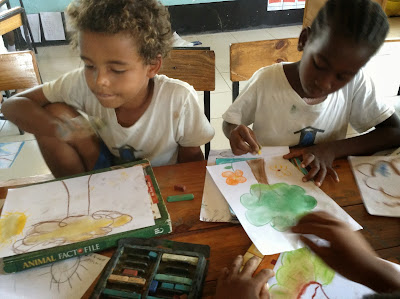We used charcoal to draw trees in dry environments. Charcoal is black so it worked very well to show that everything was dead, dying and dry. We practised drawing hard and light lines to see the difference.
 |
| Ally drawing a dry environment. |
We then had a go at using water colour to paint a spring environment full of brightly coloured flowers and leaf covered trees. We learnt about blending colours together to make the sky look more realistic.
The third table had pastels. We got to choose if we wanted to draw a sunny or stormy picture. For a stormy picture we used a lot of black, grey, brown and dark blue. For sunny pictures we used a lot of yellow and orange and other bright colours.
 |
We all really liked using watercolours but we thought that charcoal was hard to use and didn't look as pretty. We will be practising using charcoal, water colour and pastels this term and we will learn how to blend the colours to make really good artwork.
Thank you Rosa Purbrick from Australia for donating heaps of great art stuff for us to use in class. The water colour paintbrushes are a clear favourite!
Questions:
1. What are the three activities we did in art class?
2. Have you used charcoal, watercolour or pastel before? Which was your favourite?
3. Using coloured pencils, or any art equipment you have, draw a sunny and a stormy environment. How are the two pictures different?























